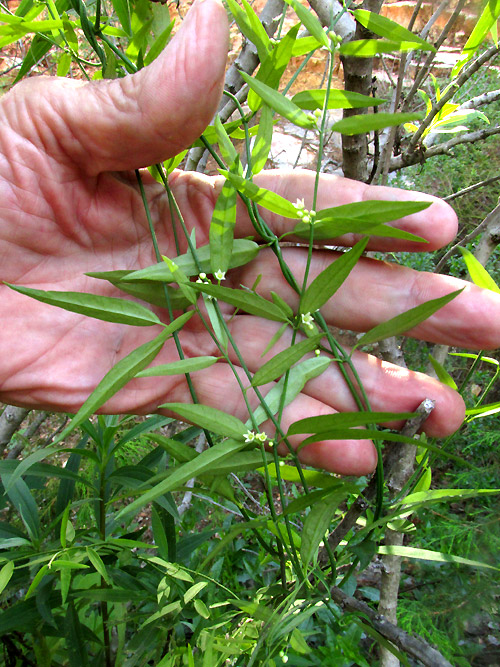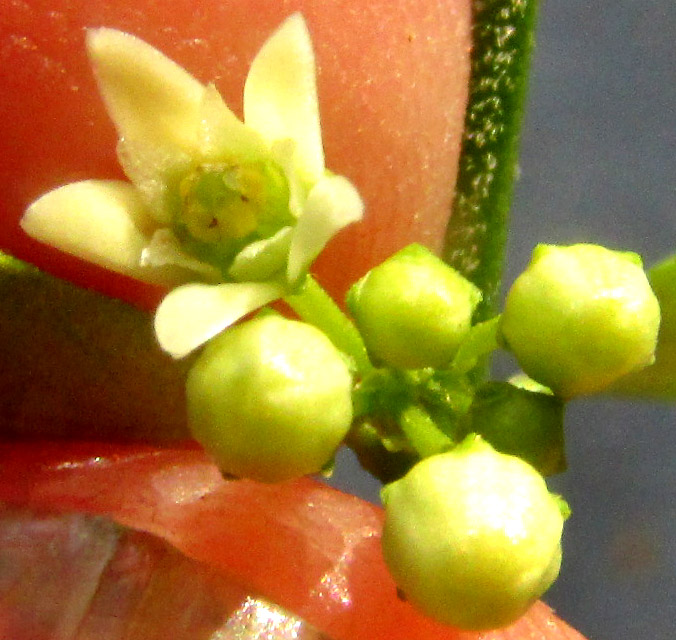Excerpts from Jim Conrad's
Naturalist Newsletter
Entry from field notes dated August 31, 2023, taken in Los Mármoles National Park in the Eastern Sierra Madre mountains, Hidalgo state, MÉXICO, along steeply climbing road heading eastward out of town of Trancas {on maps designated "Morelos (Trancas)"} toward Nicolás Flores; juniper/pine forest on limestone bedrock; elevation ~2,200m (~7,200ft); ~N20.80°, ~W99.25°
ORTHOSIA ANGUSTIFOLIA

On a very rocky, steep, mostly shaded slope made somewhat weedy by firewood gathering and cattle grazing, the above vine wound around slender branches of a woody bush. Such a fragile-looking vine with two leaves arising opposite one another, and clusters of small flowers appearing in leaf axils strongly suggests one of numerous "climbing milkweeds" of the big Dogbane Family of oleander, frangipani, and milkweed fame, the Apocynaceae. If you're not sure about this, a broken leaf immediately exudes a drop of sticky, white latex, which is the "milk."

Numerous climbing milkweed species have this general appearance, so to identify them close attention must be paid to small details. Above it's seen that the leaves are slender and sharply tipped, and the stems are short-hairy.

Features to note in the above picture are that the open blossom appears to possess two white, 5-lobed corollas, a smaller one inside a larger one. The smaller, interior one is actually a 5-lobed corona, coronas being structures typical of milkweed flowers, but in appearance taking many forms. Inside the corona a harder-to-see series of five stamens with pale, winglike appendages almost looks like yet a third 5-lobed corolla. The dark specks between the appendages are pollinia, which are waxy packages of pollen grains, typical of the family. The appendages curve upward and inward over the stigma, with the fused stigma and stamen forming the gynostegium.
The features noted above vary from genus to genus and species to species. The climbing milkweed group is so species-rich and in such need of further study that concepts of taxa and genera are in flux. The best we can do here is to determine which name currently is most used, and not be surprised if soon it's changed.
The Flora fanerogámica del Valle de México, published in 2010, probably is the most useful flora for determining climbing milkweeds in our upland central Mexican region. In that work, all the features noted above, plus the corolla being less that 2mm long, and the slender leaves gradually narrowing to their bases instead of being rounded or forming lobes, leads us to the genus Metastelma. In the Flora, our plant's detail separating it from the single other Metastelma species documented for our area is that our vine's leaves are so slender -- less than 6mm wide. Noting that, we're lead to Metastelma angustifolium. The picture below firms up the identification:

The hard-to-see detail to notice is that the stigma top -- barely visible between corona lobes -- appears to be slightly lower than the corona lobe tips, or more or less equal with them. The Flora says that to be Metastelma angustifolium the stigma top and corona lobe tips should be of equal height, or else the corona lobe tips should exceed the stigma in height, so that's further confirmation.
However, a kink in the ID process is that Kew's Plants of the World database currently reports that Metastelma angustifolium has been reassigned to the genus of Orthosia, where now it is known as ORTHOSIA ANGUSTIFOLIA; that's the name we'll use here.
Orthosia angustifolia is described as occurring in upland oak and oak-pine forests, and semiarid scrub, from northern Mexico south to Oaxaca in southern Mexico. It bears no English name, though in the Pacific state of Aguascalientes it's called hierba de la hormiga -- ant-plant. The 2015 work by Gerardo García Regalado entitled Plantas Medicinales de Aguascalientes relates that in Aguascalientes all the plant except the root can be boiled to make a tea to treat urinary problems and shoulder pain, as well as other chronic aches.
It's not surprising that any climbing milkweed has been used in traditional medicine because, as Wikipedia's page for our plant's family, the Apocynaceae, makes clear, "... many species are poisonous if ingested, the family being rich in genera containing alkaloids and cardiac glycosides." And in the world of medicine, what's toxic in one dosage often is medicinal at another.